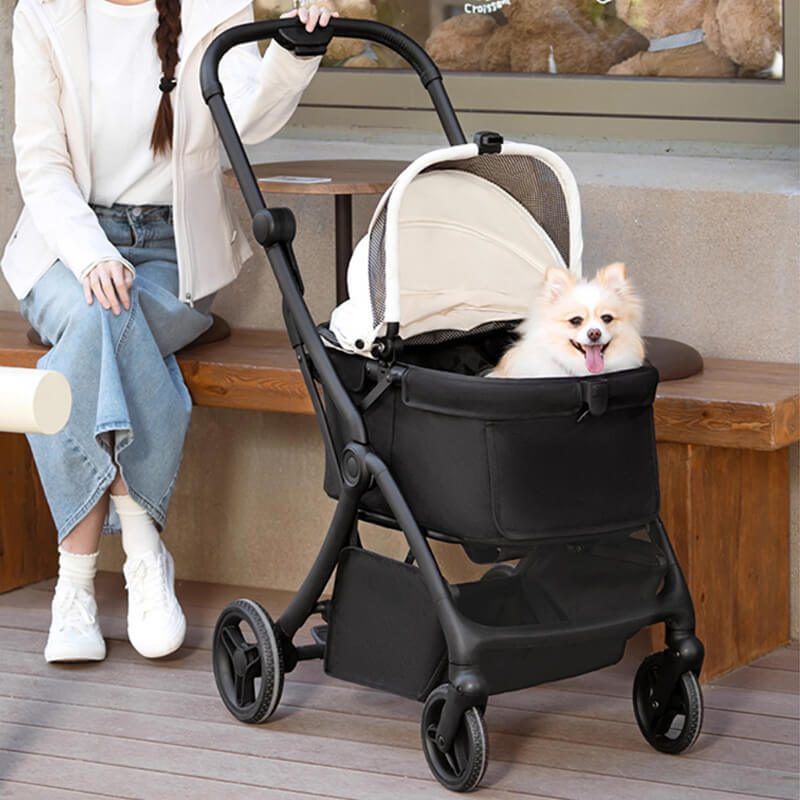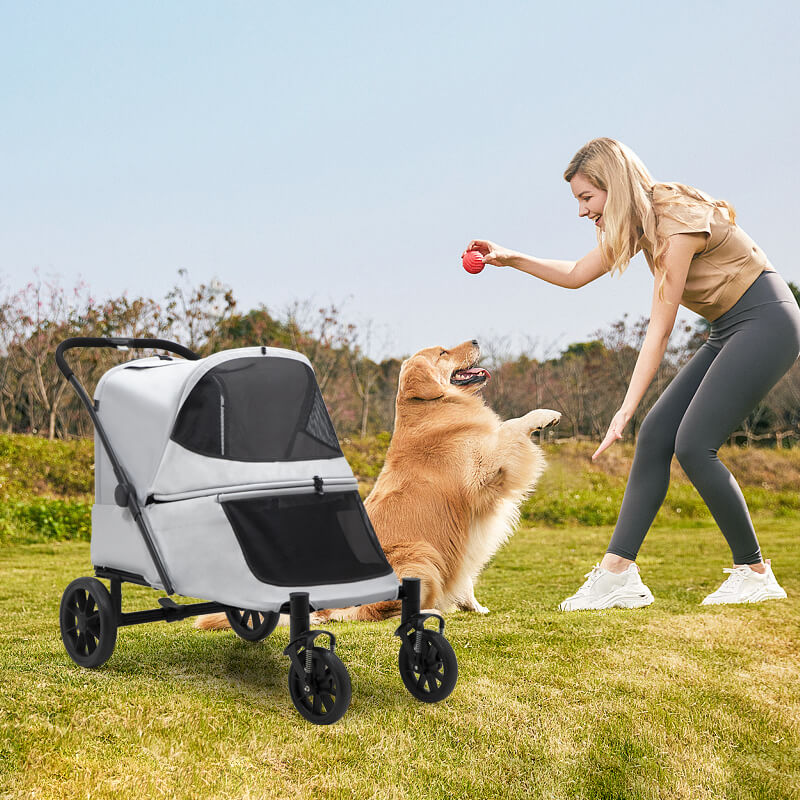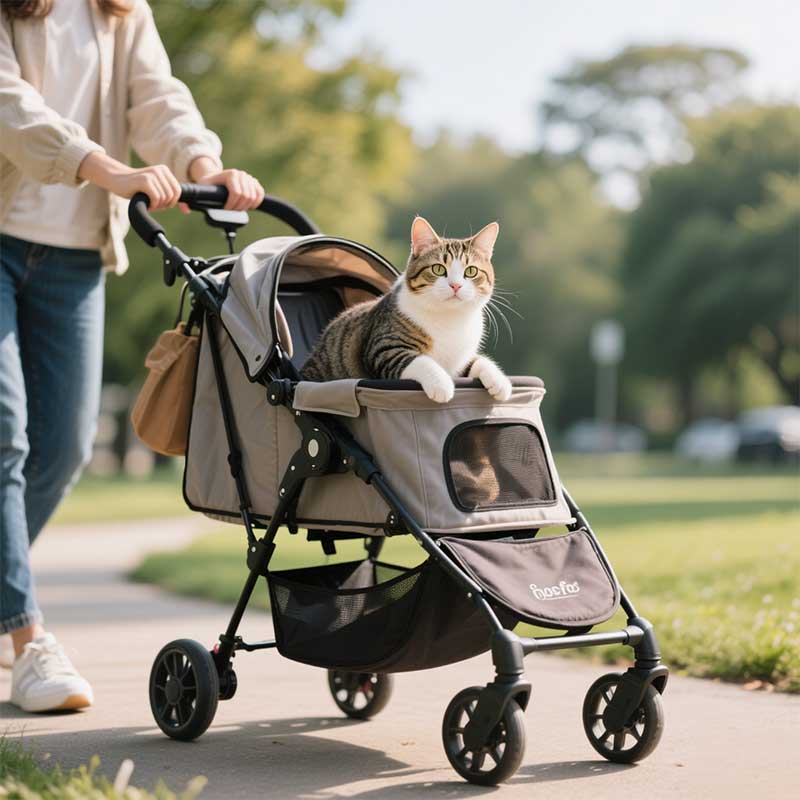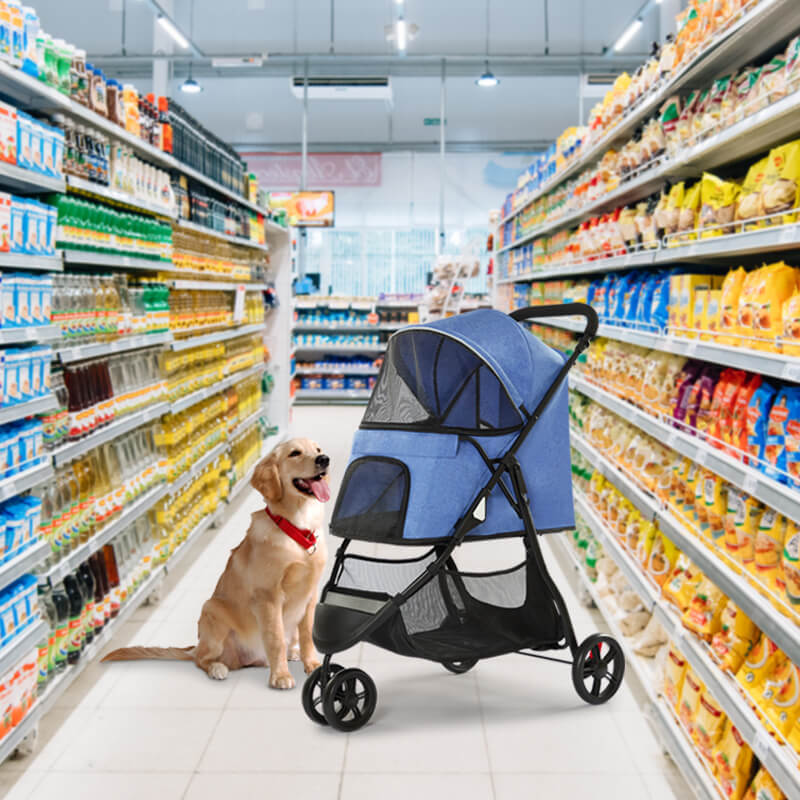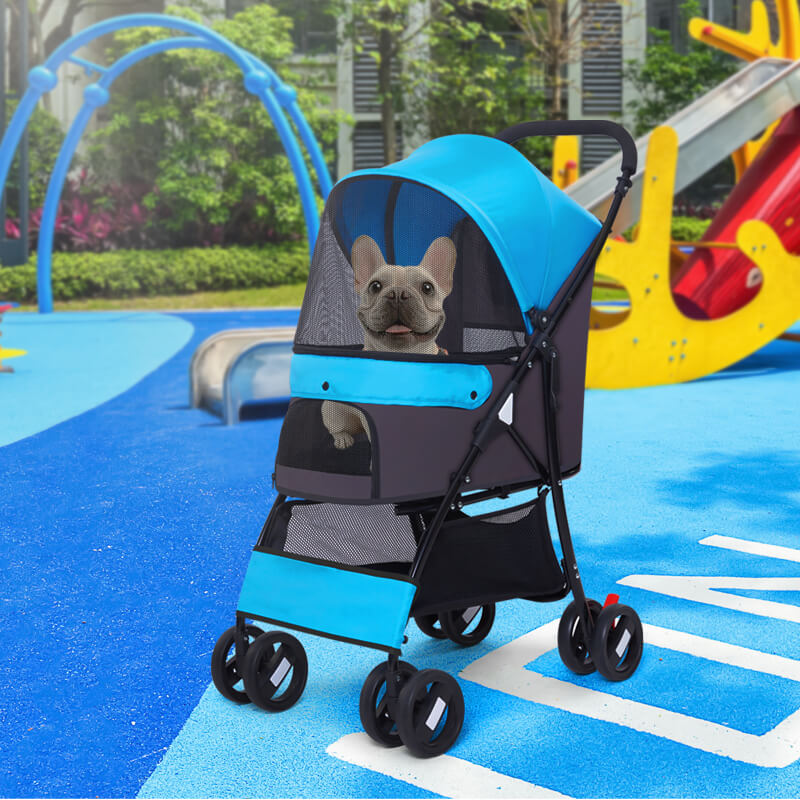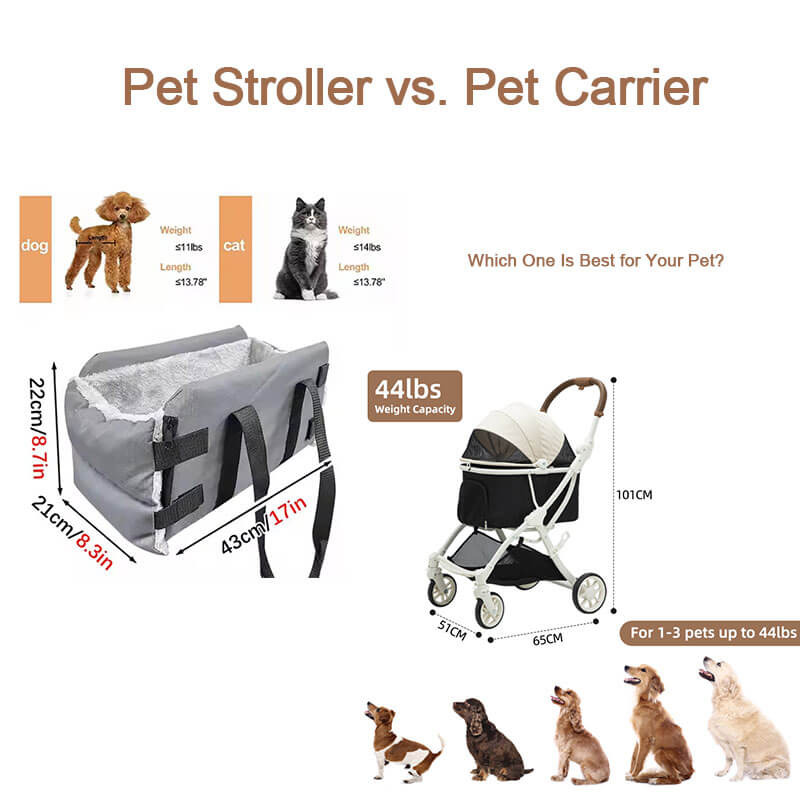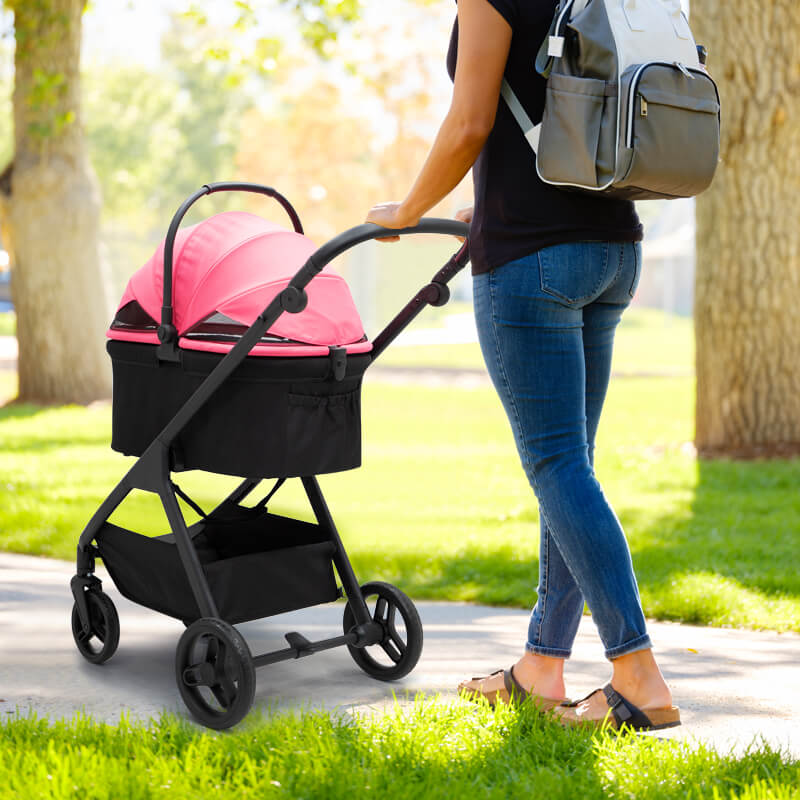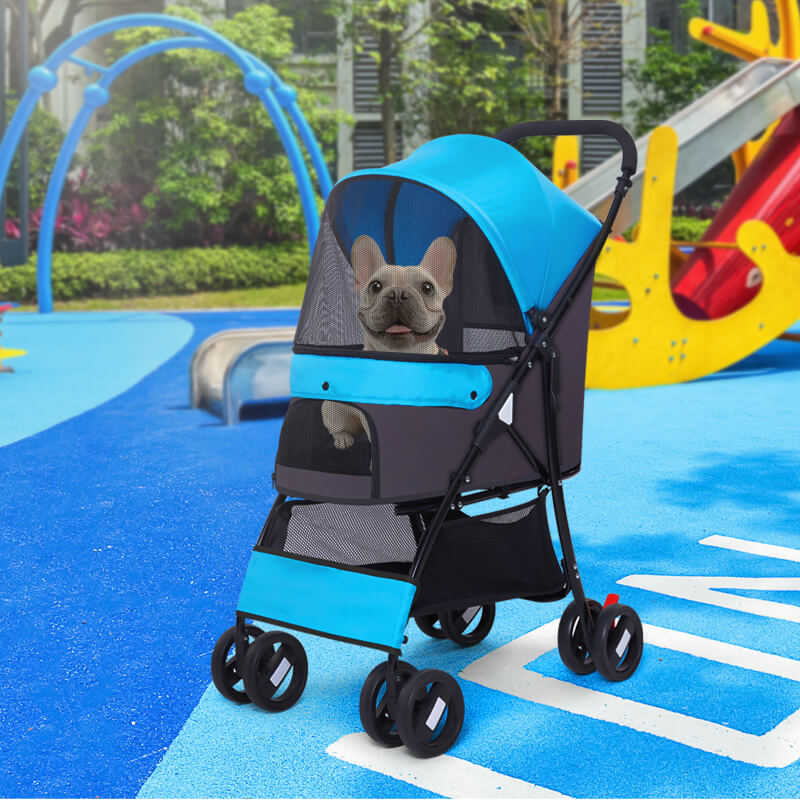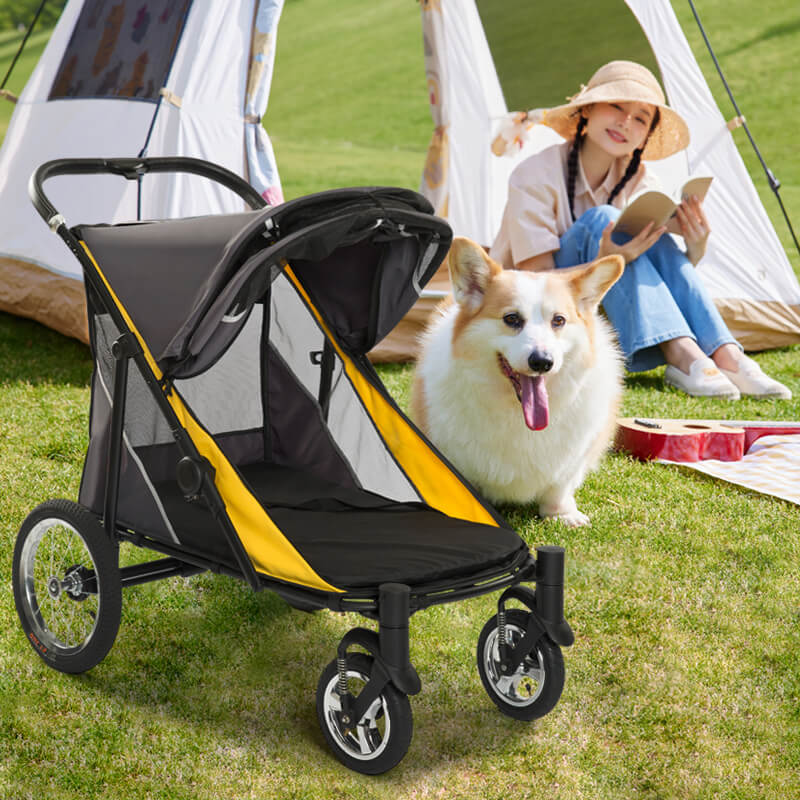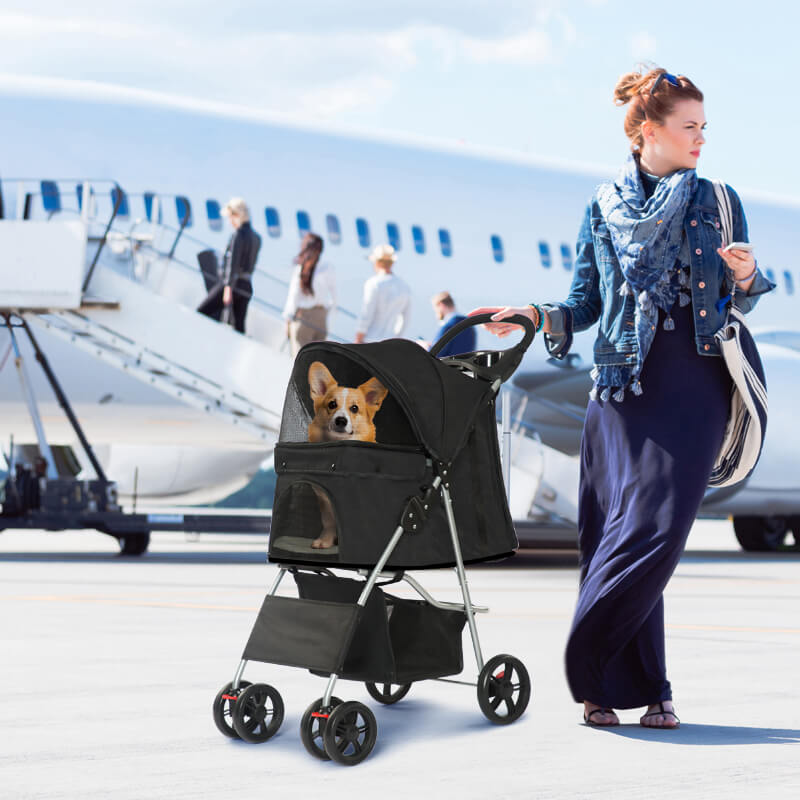¿Se puede utilizar un cochecito para mascotas en los aeropuertos?
Dec 19, 2024
Viajar con mascotas puede resultar estresante, especialmente en los aeropuertos. A cochecito para mascotas puede hacer que el viaje sea más fácil y cómodo, pero ¿puede realmente usarlo en el aeropuerto? En esta publicación de blog, exploraremos si puede o no usar un cochecito para mascotas en los aeropuertos, consejos para cumplir con las regulaciones aeroportuarias y los beneficios de traer un cochecito para tu amigo peludo.Comprender las reglas y regulaciones del aeropuerto para mascotasNormas generales aeroportuarias para cochecitos de mascotasAl viajar en el aeropuerto, los pasajeros con mascotas pueden considerar usar un cochecito para mascotas (carrito para mascotas) para garantizar que sus mascotas puedan permanecer cómodas durante las largas esperas y traslados en el aeropuerto. Sin embargo, existen ciertas regulaciones y reglas para el uso de cochecitos para mascotas en el aeropuerto. Aquí hay algunas regulaciones y precauciones comunes: 1. Política aeroportuaria generalLa mayoría de las políticas aeroportuarias para cochecitos de mascotas varían según el país, el tamaño del aeropuerto y la aerolínea. Para regulaciones específicas, consulte los siguientes aspectos:Alcance permitido de los cochecitos para mascotas: Muchos aeropuertos permiten el uso de cochecitos para mascotas en áreas de espera, puertas de embarque y algunos pasillos espaciosos. Los cochecitos para mascotas pequeños generalmente pueden pasar fácilmente por el control de seguridad, mientras que los cochecitos para mascotas grandes pueden enfrentar restricciones de espacio.Áreas restringidas: Algunos aeropuertos restringen el acceso de los cochecitos de mascotas a áreas como puertas de embarque exteriores u otros lugares concurridos, especialmente en pasillos estrechos o llenos de gente, donde los cochecitos de mascotas pueden causar molestias. 2.Regulaciones de las aerolíneasCada aerolínea tiene políticas diferentes con respecto a las mascotas, especialmente cuando se utilizan cochecitos para mascotas. Las regulaciones comunes incluyen:Si se permiten cochecitos de mascotas a bordoLa mayoría de las aerolíneas permiten que los cochecitos para mascotas se facturen como equipaje adicional o en equipaje especial, pero no todas las aerolíneas permiten cochecitos para mascotas a bordo. Por lo general, los cochecitos para mascotas deben facturarse antes de abordar, a menos que cumplan con los requisitos de tamaño para llevar como equipaje de mano.Uso de cochecitos para mascotas al abordarAlgunas aerolíneas exigen que los pasajeros retiren a sus mascotas del cochecito al abordar, y el cochecito debe guardarse y entregarse al personal para el check-in. Otras aerolíneas pueden permitir el uso de cochecitos para mascotas en la cabina por un período breve, pero deberán colocarse en un lugar designado. 3. Requisitos durante el control de seguridadProcedimientos de control de seguridad|Al pasar por el control de seguridad, los cochecitos para mascotas generalmente deben estar plegados y el propietario debe sacar y transportar a la mascota a través del canal de control de seguridad. El personal de seguridad puede pedirle al propietario que revise la mascota y el cochecito por separado, especialmente si hay dispositivos electrónicos u otros artículos en el cochecito.Escaneo de rayos XEs posible que sea necesario escanear los cochecitos para mascotas pequeños y plegables con una máquina de rayos X para garantizar que no haya artículos prohibidos. Es posible que sea necesario inspeccionar manualmente los cochecitos para mascotas más grandes. 4. Límites de tamaño y peso de los cochecitos para mascotasRequisitos de tamañoCada aeropuerto y aerolínea tiene ciertos requisitos de tamaño. La mayoría de las aerolíneas y aeropuertos tienden a permitir que solo los cochecitos para mascotas pequeños y plegables ingresen al área de seguridad, que generalmente debe cumplir con las restricciones de tamaño del equipaje de mano.Requisitos de pesoAlgunas aerolíneas limitan el peso de los cochecitos para mascotas. Por lo general, es posible que sea necesario facturar los cochecitos para mascotas con sobrepeso. 5. Notas comunesCheque anticipadoAntes de reservar un vuelo, es mejor confirmar con antelación la normativa específica sobre cochecitos para mascotas con la aerolínea para evitar problemas innecesarios al llegar al aeropuerto por incumplimiento de la normativa.Diferencias en las instalaciones aeroportuariasAlgunos aeropuertos internacionales grandes pueden ofrecer áreas exclusivas para mascotas, áreas de descanso para mascotas o servicios de alquiler de cochecitos para mascotas, especialmente para pasajeros con largos tiempos de tránsito. Es posible que los aeropuertos pequeños no tengan tales instalaciones, por lo que es necesario prepararse con anticipación.Transportín plegable para mascotasPara facilitar el acceso, lo mejor es elegir un transportín para mascotas que sea plegable y fácil de guardar, especialmente cuando el espacio es limitado en el aeropuerto. Los transportines plegables para mascotas son más flexibles y convenientes. 6. Otras soluciones alternativasMochila para mascotas|Si el transportador de mascotas no cumple con las regulaciones o el aeropuerto no permite transportadores de mascotas, una mochila para mascotas es una alternativa conveniente. No sólo mantiene a la mascota segura, sino que también le permite tener las manos libres y evitar cargar objetos voluminosos.Transportín para mascotasAlgunas mascotas pueden ser más adecuadas para un transportín, especialmente perros y gatos más pequeños, que pueden sentirse seguros y cómodos en un ambiente más cerrado.En general, existen ciertas regulaciones para el uso de transportadores de mascotas en los aeropuertos, pero las regulaciones pueden variar de un aeropuerto a otro y de una aerolínea a otra. Se recomienda comprender las políticas pertinentes antes de la salida, especialmente las regulaciones de transporte de mascotas de la aerolínea, para garantizar una seguridad y un embarque sin problemas. Al mismo tiempo, elegir un transportín para mascotas que cumpla con los requisitos y preparar algunas alternativas, como mochilas o jaulas para mascotas, puede hacer que tu viaje sea más tranquilo.Beneficios de usar un cochecito para mascotas en los aeropuertosViajar por aeropuertos con mascotas puede ser una experiencia desafiante, especialmente si tiene una mascota pequeña o mayor que puede cansarse fácilmente. Los cochecitos para mascotas, diseñados específicamente para transportar mascotas cómodamente, pueden ser un salvavidas en tales situaciones. Estos son algunos de los beneficios clave de usar un cochecito para mascotas en los aeropuertos:1. Comodidad para tu mascota Largas distanciasLos aeropuertos pueden ser enormes, y los viajeros deben caminar largas distancias entre las puertas, los controles de seguridad y la recogida de equipaje. Para perros pequeños, mascotas mayores o mascotas con problemas de movilidad, caminar esas distancias puede resultar agotador. Un cochecito para mascotas ofrece un lugar cómodo y seguro para que su mascota descanse, evitando que se canse o estrese demasiado.Protección contra superficies durasLos suelos duros y fríos de los aeropuertos pueden ser duros para las patas de su mascota. Un cochecito proporciona un entorno acolchado y protector para sus pies, manteniéndolos cómodos durante su viaje. 2. Seguridad y protecciónPrevenir fugasLos aeropuertos pueden estar abarrotados y ser caóticos, y las mascotas que no están en un cochecito podrían distraerse o asustarse fácilmente, pudiendo salir corriendo o perderse. Un cochecito mantiene a su mascota contenida de forma segura, evitando fugas o accidentes mientras navega por terminales concurridas.Evitar interacciones no deseadasEs posible que no todos los viajeros se sientan cómodos con las mascotas, y algunas mascotas pueden ponerse nerviosas con los extraños. Un cochecito mantiene a su mascota fuera del camino de forma segura, lo que reduce las posibilidades de interacciones no deseadas con otros pasajeros o mascotas. 3. Comodidad para ustedLibera tus manosNavegar por un aeropuerto con múltiples maletas, documentos y posiblemente niños puede ser un desafío. Un cochecito le permite mantener ambas manos libres, lo que le permite concentrarse en llevar su equipaje, facturar y gestionar la logística del viaje sin preocuparse por sujetar la correa de su mascota.Facilidad de movimientoLos aeropuertos suelen estar abarrotados y tratar de pasear a su mascota con una correa en espacios concurridos puede resultar frustrante. Con un cochecito podrás desplazarte por terminales, escaleras mecánicas y líneas de seguridad con mayor facilidad, sin riesgo de enredarte con una correa o de tener que lidiar con una mascota incómoda o sobreestimulada. 4. Reducción del estrés de tu mascotaAmbiente familiarMuchas mascotas se sienten reconfortadas al estar en un espacio familiar, especialmente durante eventos estresantes como un viaje. Un cochecito ofrece un entorno acogedor y seguro para su mascota, lo que reduce la ansiedad, ya que puede ver a su dueño y sentirse encerrado en un entorno familiar.Sobreestimulación reducidaLos aeropuertos pueden resultar abrumadores por su constante ruido, multitudes y movimiento. Tener un cochecito para mascotas le brinda a su mascota un lugar para retirarse de todo el ajetreo y el bullicio, ayudándole a mantener la calma y reduciendo las posibilidades de una experiencia estresante. 5. Mejor control en espacios concurridos Menos riesgo de perderse: Navegar por un aeropuerto concurrido puede resultar complicado, especialmente cuando hay grandes multitudes. Un cochecito garantiza que su mascota esté siempre al alcance de la mano, lo que reduce el riesgo de que se pierda o se enrede entre la multitud.Manejo del comportamiento de las mascotas: Si tu mascota es nerviosa, reactiva o propensa a tener arrebatos repentinos, un cochecito te ayudará a mantenerla contenida y bajo control. Esto hace que sea más fácil controlar su comportamiento mientras pasan por los controles de seguridad, áreas de embarque y salas de espera. 6. Ideal para mascotas mayores o discapacitadasMascotas mayoresLas mascotas mayores pueden sufrir dolor en las articulaciones, artritis u otras afecciones que hacen que caminar largas distancias sea difícil o doloroso. Un cochecito para mascotas puede brindarles el alivio que tanto necesitan, permitiéndoles viajar cómodamente sin exacerbar ningún problema de salud.Mascotas discapacitadasLas mascotas con discapacidades físicas, como las que se recuperan de una cirugía, pueden tener dificultades con la movilidad. Un cochecito les permite acompañarte sin el estrés de caminar o estar de pie durante largos periodos. 7. Promueve la higiene y la limpieza.Lugar de descanso limpioLos aeropuertos suelen estar abarrotados y los suelos no siempre son los más limpios. Un cochecito proporciona un espacio limpio y seguro para que su mascota descanse, lejos de los pisos potencialmente sucios de la terminal del aeropuerto.Evita accidentes con mascotasCuando las mascotas se ponen nerviosas o ansiosas, pueden sufrir accidentes en entornos desconocidos. Un cochecito puede ofrecer un entorno seguro y controlado donde usted puede gestionar más fácilmente las necesidades del baño de su mascota, manteniendo todo más limpio tanto para usted como para su mascota. 8. Conveniente para mascotas más bajas o de razas pequeñasEvite sentirse abrumadoLas mascotas más pequeñas o las razas que se ven fácilmente abrumadas por grandes multitudes pueden estresarse en áreas concurridas. Un cochecito les brinda un punto de vista más alto, lo que les permite sentirse más seguros ya que no están atrapados en el suelo ni rodeados de tráfico peatonal.Comodidad para razas pequeñasLos perros más pequeños suelen tener dificultades con las largas caminatas, esLímites de tamaño y peso: No todos los cochecitos para mascotas son lo suficientemente compactos como para caber en los espacios del aeropuerto. Es posible que sea necesario doblar algunos antes de entrar en determinadas zonas.Terminales abarrotadas: Navegar por terminales abarrotadas o espacios reducidos puede resultar un desafío con un cochecito, especialmente en aeropuertos más pequeños.Restricciones de la aerolínea: Algunas aerolíneas pueden exigirle que facture su cochecito en la puerta de embarque o limitar su uso en el avión.Retrasos de seguridad:Durante los controles de seguridad, deberás plegar el cochecito y posiblemente llevar a tu mascota a través del escáner. Esté preparado para tiempo y esfuerzo adicionales. Elegir el cochecito para mascotas adecuado para viajarCuando viaja con su mascota, tener el cochecito para mascotas adecuado puede marcar una gran diferencia en términos de comodidad, seguridad y conveniencia. Ya sea que esté navegando por un aeropuerto, una calle concurrida de la ciudad o incluso un parque lleno de gente, un buen cochecito para mascotas garantiza que su compañero peludo esté seguro y cómodo. Pero con tantas opciones en el mercado, ¿cómo eliges la mejor para tus necesidades de viaje? Estos son los factores clave a considerar al seleccionar el cochecito para mascotas adecuado para viajar1. Tamaño y capacidad de pesoTamaño de la mascota: el factor más importante a considerar es el tamaño y el peso de su mascota. Los cochecitos para mascotas vienen en varios tamaños para adaptarse a diferentes mascotas, desde pequeños cachorros y gatitos hasta perros más grandes. Verifique la capacidad de peso del cochecito para asegurarse de que pueda transportar cómodamente a su mascota sin esfuerzo.Mascotas pequeñas: Para perros o gatos pequeños (de hasta 15 libras), un cochecito compacto y liviano debería ser suficiente.Mascotas medianas: si su mascota pesa entre 15 y 30 libras, busque un cochecito con mayor capacidad de peso y suficiente espacio interior.Mascotas grandes: si su mascota pesa más de 30 libras, opte por un cochecito resistente con armazones reforzados e interiores más espaciosos.Tamaño plegado: Cuando viaje, es posible que necesite guardar el cochecito en espacios reducidos, como debajo de los asientos de un avión o en el maletero de un automóvil. Un cochecito con pliegue compacto es ideal para ahorrar espacio y comodidad durante el viaje. 2. Comodidad y acolchadoConfort interior:Elige un cochecito con un interior bien acolchado para asegurar la comodidad de tu mascota durante largas esperas o viajes. Busque cochecitos con forros o cojines suaves, removibles y lavables. Esto es particularmente importante para las mascotas que pasarán mucho tiempo en el cochecito.Ventilación: Las mascotas pueden sobrecalentarse fácilmente, especialmente en ambientes cálidos y concurridos, como aeropuertos o estaciones de tren. Un cochecito con amplia ventilación (ventanas de malla o tela transpirable) mantendrá a su mascota fresca y cómoda. Asegúrese de que el cochecito tenga múltiples paneles de ventilación para garantizar un buen flujo de aire y visibilidad para su mascota. 3. Facilidad de maniobraRuedas y Suspensión: Un cochecito con ruedas de alta calidad y una buena suspensión facilitará la navegación en diferentes terrenos, ya sea paseando por el aeropuerto, caminando por la acera o maniobrando en terrenos irregulares. Considere lo siguiente:Ruedas delanteras giratorias: Las ruedas giratorias facilitan girar el cochecito en las esquinas y navegar en espacios reducidos. Esto es especialmente útil en lugares concurridos o concurridos, como aeropuertos o calles de la ciudad.Ruedas traseras grandes: Las ruedas más grandes pueden soportar golpes y superficies rugosas mejor que las más pequeñas, lo que hace que el cochecito sea más estable y más fácil de empujar sobre terrenos irregulares.Sistema de suspensión: Un cochecito con suspensión ayuda a reducir el impacto de los golpes, haciendo que el viaje de su mascota sea más suave. 4. Plegado y portabilidadCompacto y fácil de plegar: Si viaja en avión o en tren, querrá un cochecito que sea fácil de plegar y guardar en espacios reducidos. Busque modelos que ofrezcan un mecanismo de plegado rápido y sin complicaciones, idealmente con operación con una sola mano para mayor comodidad.Diseño liviano: Un cochecito liviano es esencial si lo cargará o levantará con frecuencia, especialmente si necesita levantarlo en los compartimentos superiores o guardarlo en los baúles del automóvil.Tamaño de almacenamiento: Algunos cochecitos están diseñados para plegarse hasta alcanzar un tamaño ultracompacto, lo que los hace más fáciles de empacar y transportar. Asegúrese de que se ajuste a sus necesidades de almacenamiento y al mismo tiempo ofrezca suficiente espacio para su mascota. 5. Durabilidad y calidad de construcciónCalidad de los materiales: Elija un cochecito fabricado con materiales duraderos y de alta calidad, como aluminio o plástico resistente. Un marco bien construido puede soportar los rigores del viaje sin romperse ni perder integridad estructural.Resistencia a la intemperie:Busque cochecitos con tela resistente a la intemperie y un dosel o una cubierta para la lluvia. Ya sea que viaje bajo la lluvia o en un clima soleado, un cochecito que pueda proteger a su mascota de los elementos es una característica importante. Algunos cochecitos vienen con sombrillas incorporadas o telas de protección UV para garantizar que su mascota se mantenga fresca durante los días soleados. 6. Funciones de seguridadArnés de seguridad: Un cochecito debe tener un arnés de seguridad incorporado o una correa para asegurar a su mascota mientras viaja. Esto garantiza que su mascota permanezca segura en el cochecito, incluso si intenta saltar o moverse.Frenos: Un cochecito con frenos confiables, especialmente en las ruedas traseras, es crucial para mantenerlo estacionario cuando sea necesario (por ejemplo, cuando estás esperando en una fila o en una pendiente). Busque un cochecito con sistemas de frenos fáciles de usar que eviten que se salga rodando.Puertas con cremallera o mamparas de malla: Para evitar que su mascota se escape o salte, elija un cochecito con cremalleras seguras o mecanismos de bloqueo en las aberturas de las puertas. Además, asegúrese de que las ventanas de malla sean lo suficientemente resistentes como para resistir rayones o mordiscos. 7. Espacio de almacenamiento y extrasCestas y bolsillos de almacenamiento: Algunos cochecitos para mascotas vienen con cestas de almacenamiento adicionales o bolsillos laterales, lo que le permite llevar los elementos esenciales de su mascota, como golosinas, juguetes o sus artículos personales. Esto puede resultar especialmente útil para viajes más largos, ya que le permite guardar todo lo que necesita al alcance de la mano.Portavasos:Algunos cochecitos cuentan con portavasos para café, agua o bebida de mascota. Esta es una comodidad adicional para viajar, especialmente cuando estás en movimiento y necesitas tener las manos libres. 8. Estilo y estéticaOpciones de diseño y color: Si bien la funcionalidad es la prioridad, el aspecto del cochecito también importa, especialmente si quieres que combine con tu estilo. Muchas marcas ofrecen cochecitos para mascotas en una variedad de colores y diseños, desde elegantes y modernos hasta divertidos y coloridos. Elija uno que se adapte a sus preferencias personales y estilo de viaje. 9. Precio y valorConsideraciones presupuestarias: Los cochecitos para mascotas varían en precio según las características, la calidad de construcción y la reputación de la marca. Si bien no es necesario comprar el cochecito más caro, evite las opciones más baratas, ya que pueden carecer de características de seguridad o durabilidad esenciales.Costo versus longevidad:Considere la frecuencia con la que usará el cochecito. Si viaja con frecuencia, puede que valga la pena invertir en un cochecito más duradero y de mayor calidad. Para un uso ocasional, un cochecito de gama media podría ser suficiente. 10. Reseñas y recomendaciones de usuariosComentarios de los clientes: Antes de realizar una compra, consulte las reseñas en línea de otros dueños de mascotas que hayan usado el cochecito. Busque comentarios sobre facilidad de uso, durabilidad, comodidad y experiencias de servicio al cliente. Las recomendaciones de otros dueños de mascotas pueden darle una mejor idea de si el cochecito es el adecuado para sus necesidades.Reseñas de expertos: Busque comparaciones de cochecitos para mascotas o reseñas de expertos en línea. Algunos blogs o sitios web de productos para mascotas ofrecen desgloses detallados de diferentes modelos, lo que puede ayudarle a tomar una decisión informada. Elegir el cochecito para mascotas adecuado para viajar implica equilibrar la comodidad, la durabilidad, la facilidad de uso y la seguridad. Ya sea que estés navegando por las concurridas terminales de un aeropuerto o caminando por un paisaje urbano, un buen cochecito puede hacer que viajar con tu mascota sea mucho más placentero y libre de estrés. Al considerar el tamaño de su mascota, la portabilidad del cochecito, las características de comodidad y los aspectos de seguridad, puede seleccionar el modelo perfecto que garantice que tanto usted como su mascota tengan un viaje más tranquilo y cómodo. 5. Alternativas a los cochecitos para mascotas en el aeropuertoTransportines para mascotasMuchos aeropuertos permiten transportines para animales más pequeños. Estas pueden ser una alternativa si no se permite un cochecito. Jaulas portátiles para mascotasAlgunos viajeros prefieren jaulas plegables para mascotas para facilitar el viaje. Estos podrían ser más compatibles con los espacios del aeropuerto. Correas y ArnesesPara las mascotas que se portan bien, una correa y un arnés pueden ser la solución más sencilla cuando viajan por los aeropuertos.Consejos para viajar sin problemas con su cochecito para mascotasLlegue tempranoLos aeropuertos pueden ser impredecibles. Llegar temprano le permitirá tener tiempo adicional para manejar cualquier desafío inesperado con su cochecito y su mascota. Consulta las políticas de la aerolíneaSiempre consulte con su aerolínea con anticipación para confirmar sus reglas sobre viajar con un cochecito para mascotas.Mantenga a su mascota cómodaLleve mantas, juguetes o golosinas que le resulten familiares para ayudar a su mascota a sentirse cómoda mientras está en el cochecito. mantén la calmaLas mascotas pueden sentir la ansiedad de sus dueños. Mantener la calma ayudará a que tu mascota se sienta más segura.Usar un cochecito para mascotas en un aeropuerto puede ser una excelente manera de garantizar la comodidad y seguridad de su compañero peludo, pero requiere comprender las reglas y prepararse para los desafíos que se presentarán en el camino.Asegúrese de planificar con anticipación y elegir el cochecito adecuado que se adapte a sus necesidades de viaje. Ya sea un cochecito u otra solución, viajar con tu mascota puede ser una experiencia placentera con la preparación adecuada.Llamado a la acción¿Has utilizado un cochecito para mascotas en el aeropuerto? ¡Comparte tu experiencia en los comentarios a continuación!Para obtener más consejos de viaje para dueños de mascotas, ¡no olvides suscribirte a nuestro blog!
